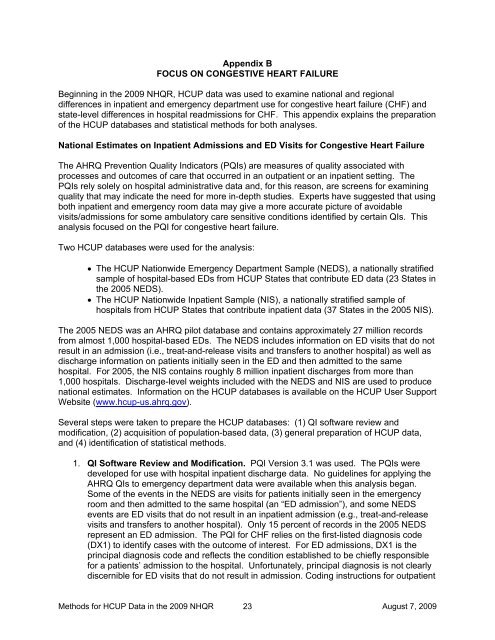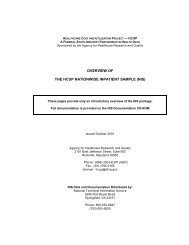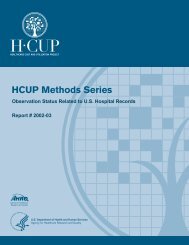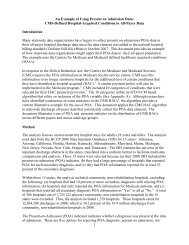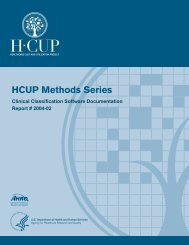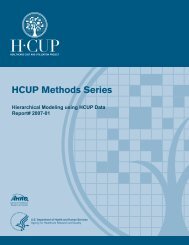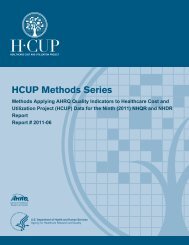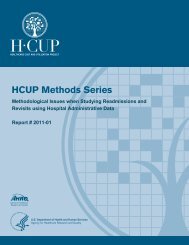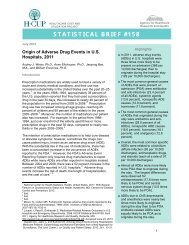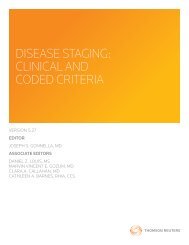Methods Applying AHRQ Quality Indicators to HCUP Data for the ...
Methods Applying AHRQ Quality Indicators to HCUP Data for the ...
Methods Applying AHRQ Quality Indicators to HCUP Data for the ...
Create successful ePaper yourself
Turn your PDF publications into a flip-book with our unique Google optimized e-Paper software.
Appendix BFOCUS ON CONGESTIVE HEART FAILUREBeginning in <strong>the</strong> 2009 NHQR, <strong>HCUP</strong> data was used <strong>to</strong> examine national and regionaldifferences in inpatient and emergency department use <strong>for</strong> congestive heart failure (CHF) andstate-level differences in hospital readmissions <strong>for</strong> CHF. This appendix explains <strong>the</strong> preparationof <strong>the</strong> <strong>HCUP</strong> databases and statistical methods <strong>for</strong> both analyses.National Estimates on Inpatient Admissions and ED Visits <strong>for</strong> Congestive Heart FailureThe <strong>AHRQ</strong> Prevention <strong>Quality</strong> <strong>Indica<strong>to</strong>rs</strong> (PQIs) are measures of quality associated withprocesses and outcomes of care that occurred in an outpatient or an inpatient setting. ThePQIs rely solely on hospital administrative data and, <strong>for</strong> this reason, are screens <strong>for</strong> examiningquality that may indicate <strong>the</strong> need <strong>for</strong> more in-depth studies. Experts have suggested that usingboth inpatient and emergency room data may give a more accurate picture of avoidablevisits/admissions <strong>for</strong> some ambula<strong>to</strong>ry care sensitive conditions identified by certain QIs. Thisanalysis focused on <strong>the</strong> PQI <strong>for</strong> congestive heart failure.Two <strong>HCUP</strong> databases were used <strong>for</strong> <strong>the</strong> analysis:• The <strong>HCUP</strong> Nationwide Emergency Department Sample (NEDS), a nationally stratifiedsample of hospital-based EDs from <strong>HCUP</strong> States that contribute ED data (23 States in<strong>the</strong> 2005 NEDS).• The <strong>HCUP</strong> Nationwide Inpatient Sample (NIS), a nationally stratified sample ofhospitals from <strong>HCUP</strong> States that contribute inpatient data (37 States in <strong>the</strong> 2005 NIS).The 2005 NEDS was an <strong>AHRQ</strong> pilot database and contains approximately 27 million recordsfrom almost 1,000 hospital-based EDs. The NEDS includes in<strong>for</strong>mation on ED visits that do notresult in an admission (i.e., treat-and-release visits and transfers <strong>to</strong> ano<strong>the</strong>r hospital) as well asdischarge in<strong>for</strong>mation on patients initially seen in <strong>the</strong> ED and <strong>the</strong>n admitted <strong>to</strong> <strong>the</strong> samehospital. For 2005, <strong>the</strong> NIS contains roughly 8 million inpatient discharges from more than1,000 hospitals. Discharge-level weights included with <strong>the</strong> NEDS and NIS are used <strong>to</strong> producenational estimates. In<strong>for</strong>mation on <strong>the</strong> <strong>HCUP</strong> databases is available on <strong>the</strong> <strong>HCUP</strong> User SupportWebsite (www.hcup-us.ahrq.gov).Several steps were taken <strong>to</strong> prepare <strong>the</strong> <strong>HCUP</strong> databases: (1) QI software review andmodification, (2) acquisition of population-based data, (3) general preparation of <strong>HCUP</strong> data,and (4) identification of statistical methods.1. QI Software Review and Modification. PQI Version 3.1 was used. The PQIs weredeveloped <strong>for</strong> use with hospital inpatient discharge data. No guidelines <strong>for</strong> applying <strong>the</strong><strong>AHRQ</strong> QIs <strong>to</strong> emergency department data were available when this analysis began.Some of <strong>the</strong> events in <strong>the</strong> NEDS are visits <strong>for</strong> patients initially seen in <strong>the</strong> emergencyroom and <strong>the</strong>n admitted <strong>to</strong> <strong>the</strong> same hospital (an “ED admission”), and some NEDSevents are ED visits that do not result in an inpatient admission (e.g., treat-and-releasevisits and transfers <strong>to</strong> ano<strong>the</strong>r hospital). Only 15 percent of records in <strong>the</strong> 2005 NEDSrepresent an ED admission. The PQI <strong>for</strong> CHF relies on <strong>the</strong> first-listed diagnosis code(DX1) <strong>to</strong> identify cases with <strong>the</strong> outcome of interest. For ED admissions, DX1 is <strong>the</strong>principal diagnosis code and reflects <strong>the</strong> condition established <strong>to</strong> be chiefly responsible<strong>for</strong> a patients’ admission <strong>to</strong> <strong>the</strong> hospital. Un<strong>for</strong>tunately, principal diagnosis is not clearlydiscernible <strong>for</strong> ED visits that do not result in admission. Coding instructions <strong>for</strong> outpatient<strong>Methods</strong> <strong>for</strong> <strong>HCUP</strong> <strong>Data</strong> in <strong>the</strong> 2009 NHQR 23August 7, 2009


